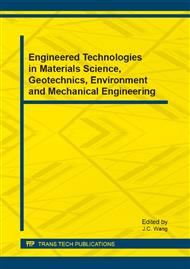[1]
R. H. U. Khan, A. Yerokhin, X. Li, et al. Surface characterization of DC plasma electrolytic oxidation treated 6082 aluminum alloy: Effect of current density and electrolyte concentration[J]. Surface & Coatings Technology, 205(2010)1679-1688.
DOI: 10.1016/j.surfcoat.2010.04.052
Google Scholar
[2]
Fangtao Xu, Yuan Xia, Guang Li. The mechanism of PEO process on Al-Si alloys with the bulk primary silicon [J]. Applied Surface Science, 255(2009)9531-9538.
DOI: 10.1016/j.apsusc.2009.07.090
Google Scholar
[3]
Lei Wen, Yaming Wang, Yu Zhou, et al. Microstructure and corrosion resistance of modified 2024 Al alloy using surface mechanical attrition treatment combined with microarc oxidation process [J]. Corrosion Science, 53(2011) 473-480.
DOI: 10.1016/j.corsci.2010.09.061
Google Scholar
[4]
Zhijiang Wanga,b, Lina Wua, Wei Caib, et al. Effects of fluoride on the structure properties of micro arc pxidation coatings on aluminium alloy [J].Journal of alloys and compounds. 505(2010)188-193.
Google Scholar
[5]
Yong-Jun Oh, Jung-Il Mun, Jung-Hwan Kim. Effects of alloying elements on microstructure and protective properties of Al2O3 coatings formed on aluminum alloy substrates by plasma electrolysis[J]. Surface & Coatings Technology, 204(2009)141-148.
DOI: 10.1016/j.surfcoat.2009.07.002
Google Scholar
[6]
K. Tillous, T. Toll-Duchanoy, E. Bauer-Grosse, et al. Micro-structure and Phase Composition of Microarc Oxidation Surface Layers Formed on Aluminum and Its Alloys 2214-T6 and 7050-T74[J]. Surface & Coatings Technology, 203(2009)2969-2973.
DOI: 10.1016/j.surfcoat.2009.03.021
Google Scholar
[7]
J.A. Curran , T.W. Clyne. Thermo-physical properties of plasma electrolytic oxide coatings on aluminum [J]. Surface & Coatings Technology,199(2005)168-176.
DOI: 10.1016/j.surfcoat.2004.09.037
Google Scholar
[8]
Klapkiv M D.State of an electrolytic plasma in the process of synthesis of oxides based on aluminum [J]. Mater Sci,31 (1995)494-498.
DOI: 10.1007/bf00559144
Google Scholar
[9]
V.Raj*, M. Mubarak Ali. Formation of ceramic alumina nanocomposite coatings on aluminium for enhanced corrosion resistance [J]. Journal of Materials Processing Technology, 209(2009)5341-5352.
DOI: 10.1016/j.jmatprotec.2009.04.004
Google Scholar
[10]
Guohua Lv, Weichao Gu, Huan Chen, et al. Characteristic of ceramic coatings on aluminum by plasma electrolytic oxidation in silicate and phosphate electrolyte [J]. Applied Surface Science, 253(2006)2947-2952.
DOI: 10.1016/j.apsusc.2006.06.036
Google Scholar


